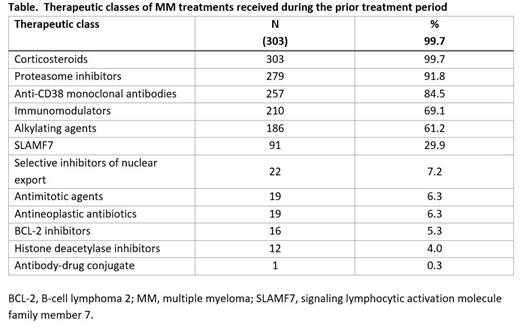Abstract
Introduction: Belantamab mafodotin (belamaf) is a first-in-class B-cell maturation antigen-targeting antibody-drug conjugate, with a manageable adverse event profile, that has shown durable efficacy in a broad range of patients with relapsed or refractory multiple myeloma (RRMM) (Lonial et al., Lancet Oncol. 2020). As belamaf is an approved therapy, it is important to understand how it is being integrated into the management of patients with RRMM. The aim of this analysis was to examine baseline demographic and treatment patterns of these patients prior to belamaf in a real-world clinical practice.
Methods: This descriptive, retrospective cohort study used IQVIA's longitudinal pharmacy and medical open source claims database, a nationally representative real-world database. The study covered the period from January 2001 to April 2021. Patient inclusion into the study required belamaf treatment initiation and ≥18 years of age at initiation. The first claim date for belamaf during the index period (August 2020 to April 2021) was the index date (ID). Key measures included patient demographics and prior MM treatments. Patient demographics were identified at the ID. Prior MM treatments were assessed during the prior treatment period, which extended from the database start date (January 2001) until the ID. The definition of a line of therapy (LOT) used in this analysis was consistent with published guidance (Rajkumar SV, et al. Blood, 2015;126:921-922). Treatments of interest were identified within the first 28 days of the first observed claim for MM treatment. A new LOT was identified if a new treatment was added after the initial 28 days after the start of the LOT, ≥1 treatment was discontinued (defined by a coverage gap >60 days), or the same LOT was restarted at a later date if ≥1 regimen was administered in between. Different therapeutic classes (e.g. PIs, immunomodulatory drugs, anti-CD38 antibodies) could be used in each LOT either singly or in combinations. Addition/deletion of corticosteriods did not constitute a new LOT.
Results: 304 patients with a claim for belamaf were identified in the database and included in the analysis; median age was 70 years and 50.3% were female. Median (range) time from the earliest observed claim for MM treatment during the prior treatment period to the ID was 1,812 (104─6,676) days. Median (range) time from the earliest observed diagnosis for MM during the prior treatment period to the ID was 2,123 (22-7,186) days (~5.8 years). The median number of MM therapeutic classes, overall, received during the prior treatment period was 5; 82.9% of patients with MM received ≥4 classes of MM therapy. Prior therapy for MM was observed for 303 patients; the therapeutic classes of those MM treatments are shown in the Table. The median number of observed LOTs received by patients in the prior treatment period was 5 and 73.0% had ≥4 LOTs.
LOT for belamaf may be over/under estimated as reporting on some of the MM medications was embargoed by manufacturers and/or specialty pharmacies for certain periods of time, leading to some incompleteness of data. Embargoed products included lenalidomide, pomalidomide, selinexor, thalidomide, ixazomib, and bortezomib. Although data capture for these MM treatments may not be complete in open source claims, some of the claims data for these medications were included in this analysis, i.e., medical claims for infused medications and pharmacy claims from switch suppliers for oral medications.
Conclusions: The real-world evidence analyzed in this study is in line with the baseline characteristics reported for the DREAMM-1 and DREAMM-2 trials (Lonial et al., Lancet Oncol. 2020, Trudel et al., Blood Cancer J., 2019). Patients receiving belamaf have triple-class refractory myeloma with multiple LOTs generally aligned with the current indication. The most frequent prior treatments included proteasome inhibitors, anti-CD38 monoclonal antibodies, immunomodulatory drugs, and corticosteroids. Corticosteroid use is high as it is required to be prescribed in combination with other drugs according to their indications. This study identified patients in the US receiving belamaf and provides early insights into the patient demographic and clinical characteristics as well as number and range of treatments prior to treatment with belamaf.
Funding: GSK (Study 214283).
Boytsov: GlaxoSmithKline: Current Employment, Current equity holder in publicly-traded company. Stockl: IQVIA: Current Employment; GlaxoSmithKline: Research Funding. Chen: GlaxoSmithKline: Research Funding; IQVIA: Current Employment. Wang: GlaxoSmithKline: Current Employment, Current equity holder in publicly-traded company. Wang: IQVIA: Current Employment; GlaxoSmithKline: Research Funding. Cao: IQVIA: Current Employment. Doherty: GlaxoSmithKline: Current Employment, Current equity holder in publicly-traded company. Paka: GlaxoSmithKline: Current Employment, Current equity holder in publicly-traded company.


This feature is available to Subscribers Only
Sign In or Create an Account Close Modal